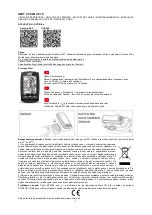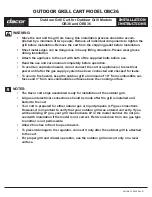
DELIVERY AND STORAGE
Inspect for signs of damage or missing
components.
Store the battery in a dry, clean and prefe-
rably cool and frost-free location. Do not
expose the cells to direct sunlight as dama-
ge to the container and cover may occur.
As the batteries are supplied charged, sto-
rage time is limited. In order to easily char-
ge the batteries after prolonged storage, it
is advised not to store it more than
6 months at 20°C
4 months at 30°C
2 months at 40°C
A refreshing charge shall be performed
after this time or if the open circuit voltage
is below 2.07 Vpc.
Failure to observe these conditions may
result in greatly reduced capacity and ser-
vice life.
The refreshing charge shall be carried out
according to clause a) of the commissio-
ning charge paragraph below. Alternatively
the cells can be float-charged at 2.25 Vpc
during storage.
INSTALLATION
The electrical protective measures and the
accommodation and ventilation of the bat-
tery installation must be in accordance with
the applicable rules and regulations.
Specifically EN 50272-2 applies.
The battery should be installed in a clean,
dry area. It will not emit corrosive gases in
normal operation and can be installed
together with other electrical equipment.
Under normal conditions the gas release is
negligible and natural ventilation is suffi-
cient for cooling purposes and inadvertent
overcharge, enabling OPzV batteries to be
used safely in offices or within equipment.
However care must be taken to ensure
adequate ventilation when placed in
cabinets. They must not be placed in sealed
cabinets without ventilation openings at
the top and bottom.Avoid placing the
battery in a warm place or in direct sun-
light. Approved battery racks are recom-
mended for proper installation. Place the
cells on the rack and arrange the positive
and the negative terminals for connection
according the wiring diagram.
Horizontal Installation
Do not install the cells in such a way that
the box-lid bond is resting on a runner.
Ensure that the internal plates are vertical.
Check that all contact surfaces are clean. If
required clean with a brass brush. Tighten
the terminal screws, taking care to use the
correct torque loading (Tab. 1). To avoid
damage to the plastic materials, do not use
grease. Fit the covers supplied for protec-
tion against inadvertent contact.
Tab. 1: Torque loadings for terminal screws
Type Terminal screw
Torque
OPzV
M10
23 – 25 Nm
Carefully follow the polarity sequence to
avoid short circuiting cell groups. A loose
connector can make adjusting the charger
difficult, create erratic performance and
possible damage to the battery and/or
even personal injury. Finally, with the char-
ger switched off, the battery fuses remo-
ved and the load disconnected, connect
the battery to the D.C. power supply.
Ensure that the polarity is correct - positi-
ve terminal of the battery to the positive
terminal of the charger. Switch on the
charger and charge according to the com-
missioning charge paragraph below. The
first charge must be monitored to ensure
that the limits are not exceeded and that
no unacceptable temperatures occur.
Cells or monoblocs in parallel strings
OPzV cells monoblocs may be connected
in parallel to give higher current
capability. In the case of parallel connec-
ted strings, use batteries of the same
capacity, design and age only with a maxi-
mum of 4 parallel strings. The resistance
of the cables in each string must be the
same, e.g. same cross-section, same
length. Connect the battery strings in
parallel at the charger terminals.
Handling
OPzV batteries are supplied in a fully charged
state and must be unpacked carefully to avoid
short-circuit between terminals of opposite
polarity. The cells are heavy and must be lifted
with appropriate equipment.
Keep Flames Away
In the case of an accidental overcharge, a flam-
mable gas may be emitted from the safety valve.
Discharge any possible static electricity
from clothes by touching an earth-connected
part.
Tools
Use tools with insulated handles.
Do not place or drop metal objects onto the
battery. Remove rings, wristwatch and metal arti-
cles of clothing that might come into contact
with the battery terminals.
Warranty
Any of the following actions will invalidate the warrranty - Non-adherence to the Installation, Operating and Maintenance instructions.
Repairs carried out with non-approved spare parts. Application of additives to the electrolyte. Unauthorised interference with the battery.
PowerSafe OPzV
Installation, operating
and maintenance instructions
E
N
G
L
IS
H
No smoking no naked
flames, no sparks
Electrical hazard
Electrolyte is corrosive,
in case of broken
containers/lids
Shield eyes
Danger
Clean all acid splash in eyes or
on skin with lot of clear water.
Then visit a doctor.
Acid on clothing is to be washed
with water.
+
Note operating
instructions
Recycle scrap
batteries.
Contains lead
Warning: Risk of fire, explosion, or
burns. Do not disassemble, heat
above 60ºC, or incinerate. Avoid
any short circuit. Metallic parts
under voltage on the battery, do not place tools
or items on top of the battery
DELIVERY AND STORAGE
Inspect for signs of damage or missing
components.
Store the battery in a dry, clean and
preferably cool and frost-free location. Do
not expose the cells to direct sunlight as
damage to the container and cover may
occur. As the batteries are supplied charged,
storage time is limited. In order to easily
charge the batteries after prolonged storage,
it is advised not to store it more than
12 months at 20°C
6 months at 30°C
3 months at 40°C
A refreshing charge shall be performed after
this time or if the open circuit voltage is
below 2.07 Vpc.
Failure to observe these conditions may
result in greatly reduced capacity and service
life.
The refreshing charge shall be carried out
according to clause a) of the commissioning
charge paragraph below. Alternatively the
cells can be float-charged at 2.25 Vpc during
storage.
INSTALLATION
The electrical protective measures and the
accommodation and ventilation of the
battery installation must be in accordance
with the applicable rules and regulations.
Specifically EN 50272-2 applies.
Do not use terminal posts to lift or handle
cells.
The battery should be installed in a clean, dry
area. It will not emit corrosive gases in
normal operation and can be installed
together with other electrical equipment.
Under normal conditions the gas release is
negligible and natural ventilation is sufficient
for cooling purposes and inadvertent
overcharge, enabling OPzV batteries to be
used safely in offices or within equipment.
However care must be taken to ensure
adequate ventilation when placed in
cabinets. They must not be placed in sealed
cabinets without ventilation openings at the
top and bottom. Avoid placing the battery in
a warm place or in direct sunlight. Approved
battery racks are recommended for proper
installation. Place the cells on the rack and
arrange the positive and the negative
terminals for connection according the wiring
diagram.
Horizontal Installation
Do not use terminal posts to lift or handle
cells.
Do not install the cells in such a way that the
box-lid bond is resting on a runner. Always
ensure that the arrow on the lid of each unit
is pointing in vertical orientation.
Do not invert cells (vents upside down) or
allow the front of the cells to be positioned
lower than the base of the cell as it might
block the safety valve and damage pillars.
Check that all contact surfaces are clean. If
required clean with a brass brush. Tighten
the terminal screws, taking care to use the
correct torque loading (Tab. 1). To avoid
damage to the plastic materials, do not use
grease. Fit the covers supplied for protection
against inadvertent contact.
Tab. 1: Torque loadings for terminal screws
Type Terminal screw Torque
OPzV M10 23 – 25 Nm
Carefully follow the polarity sequence to
avoid short circuiting cell groups. A loose
connector can make adjusting the charger
difficult, create erratic performance and
possible damage to the battery and/or even
personal injury. Finally, with the charger
switched off, the battery fuses removed and
the load disconnected, connect the battery
to the D.C. power supply.
Ensure that the polarity is correct -
positive terminal of the battery to the positive
terminal of the charger. Switch on the
charger and charge according to the
commissioning charge paragraph below. The
first charge must be monitored to ensure that
the limits are not exceeded and that no
unacceptable temperatures occur.
Cells or monoblocs in parallel strings
OPzV cells monoblocs may be connected in
parallel to give higher current capability. In
the case of parallel connected strings, use
batteries of the same capacity, design and
age only with a maximum of 4 parallel
strings. The resistance of the cables in each
string must be the same, e.g. same cross-
section, same length. Connect the battery
strings in parallel at the charger terminals
1
Содержание PowerSafe OPzV Series
Страница 10: ...Notes ...
Страница 11: ......






























